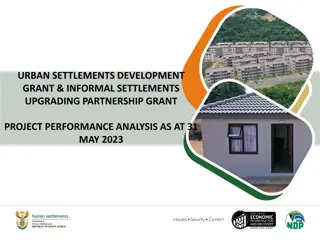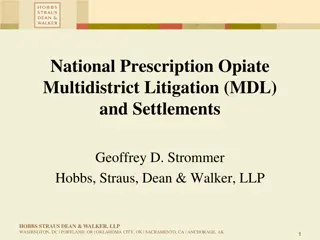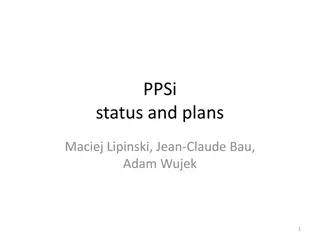
Point-to-Point Obligation (PTP) Settlements
PTP Clearing and Settlement Difference Concern: Addressing price differences in clearing and settlement processes of Point-to-Point Obligations. Proposed change aims to distribute power more effectively to maintain balance and consistent pricing. Implementation in other ISOs like MISO, CAISO, and PJM varies in handling outage scenarios. Examples provided show strategies to manage congestion and maintain grid stability.
Download Presentation

Please find below an Image/Link to download the presentation.
The content on the website is provided AS IS for your information and personal use only. It may not be sold, licensed, or shared on other websites without obtaining consent from the author. If you encounter any issues during the download, it is possible that the publisher has removed the file from their server.
You are allowed to download the files provided on this website for personal or commercial use, subject to the condition that they are used lawfully. All files are the property of their respective owners.
The content on the website is provided AS IS for your information and personal use only. It may not be sold, licensed, or shared on other websites without obtaining consent from the author.
E N D
Presentation Transcript
Point-to-Point Obligation (PTP) Settlements and Clearing Difference QMWG May 1, 2017
PTP Clearing and Settlement Difference Concern: Price difference between clearing and settlement of PTPs A contingency de-energizes one side of the PTP and causes an constraint to bind at high shadow price and hence high price at energized side To maintain power balance under PTP analysis, DAM creates an exception to exclude this contingency/constraint s impact in PTP clearing due to one side being de-energized LMP at the energized side takes into account this constraint s impact Proposed Change: To maintain power balance under PTP analysis, Instead of ignoring the congestion impacts of one side de-energized PTPs, modify DAM optimization to distribute the PTP MW from the disconnected Settlement Point to all the other online generators Makes optimization and settlement price consistent within a small tolerance Pickup effect ensures power balance in the post-contingency power flow and has minimal impact on the congestion pattern based on historic analysis Binding constraints under N-1 are mainly due to power flow redirections caused by the topology change under N-1 contingency and not due to the pickup effect of the tripped generator 2 PUBLIC
Implementation in Other ISOs MISO ISO-NE CAISO Proposed PJM ERCOT proposal Model G-1 in DAM? No No No Yes No Model N-1 that outages generator Yes Yes Yes Yes Yes How MWs redistributed in DAM? AGC units based on participation factor AGC units based on participation factor AGC units based on max power capability All online resources based on headroom All online resources based on HRL What is the SF of de-energized bus to N-1 contingency? Set to zero Set to zero Set to zero Set to zero Set to zero *SPP have identified issues with current implementation and are changing it to be consistent with other ISOs 3 PUBLIC
N-1 Example BASE CASE Station B Station A RNsi Station C Station G Station D GRID RNso RNsi Station F Station E Outage Gen Station 4 PUBLIC
N-1 Example Congestion Due to Power Flow Change and not due to pickup effect CONTINGENCY 1 Binding Station B Station A RNsi Station C Station G Station D GRID RNso RNsi Station F Station E Outage Gen Station 5 PUBLIC
NPRR827 If the desire for implementation for this urgent NPRR is to zero out awards that are greater than their bid price Need to set a lower limit to decrease manual work Language change needed: PTP Obligation bids shall not be awarded where the DAM clearing price for the PTP Obligation is greater than the PTP Obligation bid pricewithin a small threshold. Impacts of zeroing out awards Could remove hedging opportunities for other constraints and therefore cannot be a long-term solution: this is not a base case issue, it is post contingency for one constraint Can cause shortfall because removed PTP bids could be providing counter flow 6 PUBLIC
NPRR827 Frequency of PTP awards above bid prices, 2016 & 2017 through February:(without pickup effect implemented) Range ($) 0-0.1 0.1-0.5 0.5-1 1-5 5-10 10-50 50-100 100-500 500-1000 Over 1000 2017 Frequency 21 39 25 188 421 1241 99 413 213 297 Range ($) 0-0.1 0.1-0.5 0.5-1 1-5 5-10 10-50 More 2016 Frequency 296 262 105 359 76 11 0 7 PUBLIC
Appendix 8 PUBLIC
Pick-up effect example for virtuals, TPOs When a generator is disconnected from the rest of the system under a contingency case The MWs from the generator are redistributed to the connected, online generators to maintain power balance under the contingency The generator s MWs have impact based on the impact of the resources to which the MW is distributed. Hence, the generator has an equivalent shift factor to the constraint (distributed MW weighted SF of all resources - pickup effect shift factor a very small value) even though it is disconnected MWs flowing from generator in base case Gen 1 This line is disconnected under contingency Other generators This line is outaged Redistributed MWs The rest of the system PUBLIC
Pick-up effect example for virtuals, TPOs Example of MW weighting. When distributing to all generators in the system, the equivalent impact to constraint will be near zero. All generators in systemGenerator HRL-weighted shift factor - HRL-weighted distribution factor Each generator s shift factor on constraint HRL (MW) n/a Gen 1 (disconnected) - - Gen 2 (offline) n/a - - - Gen 3 Gen 4 50 70 .25 .35 -.02 .01 -.0050 .0035 Gen 5 80 .40 .01 .0040 Disconnected settlement point s shift factor on binding constraint (sum of HRL-weighted shift factors) = .0025 PUBLIC
Other Related Issues A concern has been raised about explicit G-1 contingencies This issue is different from the PTP implementation concern in that the contingencies causing the PTP implementation concern are Transmission contingencies which outage a Resource Node as well and hence no concern with difference in optimization price and RN SPP Consistently modeled across CRR/DAM/RT and hence there are no systemic uplift possibilities There is further discussion needed about explicit G-1 contingencies in Real-Time causing potential overselling but this is a different issue which could be addressed later. 12 PUBLIC
Clarification Needed for NPRR827 Key to determine implementation to determine the exact language Implementation options discussed- Zero out awards which are affected Could remove hedging opportunities for other constraints and therefore cannot be a long-term solution: this is not a base case issue, it is post contingency for one constraint Can cause shortfall because removed PTP bids could be providing counter flow Settle at the optimization price Concerns with gaming Will not be able to implement manually 13 PUBLIC
Alternative Language for NPRR827 Other long term implementation options discussed Removing the contingencies Need to be evaluated for reliability Removing from SCED/DAM/CRR and do Out of Market action Not a preferred option by ERCOT operations Requires extensive system changes and testing Increases out of market actions Cause Uplift Removing from just DAM/CRR and keeping in SCED would cause overselling and revenue neutrality charges ERCOT proposed optimization change Language change needed - PTP Obligation bids shall not be awarded where the DAM clearing price for the PTP Obligation is greater than the PTP Obligation bid price within a small threshold. 14 PUBLIC
Merits of ERCOT option Contingencies that cause PTP implementation concern Must be considered for reliability in Real-Time to ensure there are no transmission equipment violations. Must be in SCED to avoid Uplift from Out of market actions Hence must be consider in DAM to ensure consistency and maintain revenue neutrality. To maintain power balance in the post-contingency power flow, DAM optimization will be changed to distribute the PTP MW from the disconnected Settlement Point to all the other connected generators Would make optimization price and settlement price consistent within a small tolerance The post contingency flows based on simulated governor response ERCOT design calculates prices based on pre-contingency dispatching of resources to meet post contingency overloads. Contingencies that cause PTP implementation concern are considered the same and hence are not over constraining Similar to implementation by other ISOs 15 PUBLIC
Appendix 16 PUBLIC
Overview A PTP is modeled as a simultaneous injection and withdrawal a linked bid and offer Clearing price and SPP difference diverge when Under a contingency a settlement point associated with either the PTP sink or source is disconnected A constraint becomes violated/binding under the contingency The shift factor for the connected settlement point is non-trivial The constraint remains binding for the final DAM solution 17 PUBLIC
Modeling DAM PTPs in Contingency Analysis Under contingency analysis a contingency disconnects one of the source/sink settlement points PTPsource PTPsink In order to keep post-contingency power balance, any PTP containing a disconnected settlement point will be ignored in the post-contingency power flow. 18 PUBLIC
Clearing Price for PTP with source disconnected in a contingency The clearing (optimization) price for PTPs would be: ????????????=Lambda ?????? ???????????? ??????? ?????? (Lambda ???????? ???????????? ) = ???????? ???????????? ?????? ???????????? ??=shift factor ??=shadow price of constraint If we have three constraints, but the second contingency constraint disconnects the source of the PTP, then the clearing (optimization) price of the PTP would be: ????????????= ???? 1 ???1 ???? 3 ???3 1 ???1 + ???? 3 ???3 ???? ??????? ?????? 2 ???2 does not appear as this PTP is removed for the second *Note that the term ???? 2 ???2 ???? contingency. Also, ???? 2=0 19 PUBLIC
DAM Settlement Point Price The Settlement Point Prices (SPP) at a Settlement Point is given by: ??? = ?? ???????????? = system lambda ??=shift factor ??=shadow price If we have three constraints, but a contingency disconnects the Settlement Point source on the second constraint, the SPP at source would be: 1 ???1 ???? 2 ???2 ???? 3???? ???3 ????? = ???? 2=0, thus, As ???? 1 ???1 ???? 3???? ???3 ????? = ???? The SPP at another Settlement Point sink that is energized for the second constraint is 1 ???1 ???? 2 ???2 ???? 3 ???3 ????? = ???? 20 PUBLIC
PTP settlement discrepancy when source disconnected in a contingency The DAM settlement for PTPs is the difference of the sink SPP and the source SPP: The clearing price / DAM optimization price for PTPs would be: Difference between what the PTP is settled at and what the DAM clearing/optimization sees is: End result Under certain conditions, the awarded PTP could be settled at a price different from the clearing/optimization price 21 PUBLIC
Possible alternatives Preferred option - Change how DAM processes PTP in contingency analysis when a contingency disconnects the source or sink To maintain power balance in the post-contingency power flow, rather than ignoring PTP in post-contingency power flow, distribute the PTP MW from the disconnected Settlement Point to all the other connected generators Would make optimization price and settlement price consistent within a small tolerance Considerations: PTP flow could contribute to congestion far removed from the path Would have to consider changing CRR auction to make consistent Requires system change and extensive testing 22 PUBLIC
Possible alternatives Alternative option - Change settlement price for PTP bids to the optimization price Makes the DAM clearing engine and settlements consistent Buyer will never see clearing higher than bid Considerations: CRR value and PTP cost would diverge Would affect Balancing Account Gaming opportunities exist Requires NPRR and integrated system changes CRR DAM RT CRR charged at optimization price CRR settles on SPP difference PTP pays optimization price PTP settles on SPP difference Over/under goes to Balancing Account Over/under goes to RT Rev. Neutrality Allocation 23 PUBLIC






















